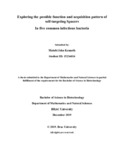| dc.contributor.advisor | Tareq, Md. Tokee | |
| dc.contributor.author | Kenneth, Mutebi John | |
| dc.date.accessioned | 2019-12-11T10:41:12Z | |
| dc.date.available | 2019-12-11T10:41:12Z | |
| dc.date.copyright | 2019 | |
| dc.date.issued | 2019-12 | |
| dc.identifier.other | ID 15236014 | |
| dc.identifier.uri | http://hdl.handle.net/10361/13256 | |
| dc.description | This thesis is submitted in partial fulfillment of the requirements for the degree of Bachelor of Science in Biotechnology, 2019. | en_US |
| dc.description | Cataloged from PDF version of thesis. | |
| dc.description | Includes bibliographical references (pages 33-42). | |
| dc.description.abstract | The adaptive immunity in prokaryotes known as Clustered Regularly Interspaced Short Palindromic Repeats (CRISPR) and its CRISPR associated (Cas) genes provide the encoding organisms with the ability to resist invasive genetic elements such as viruses, plasmids, and transposons. CRISPR-Cas system confers this immunity through incorporating nucleic acid derived spacers into CRISPR arrays which provide genetic memories that are a pre-requisite for subsequent neutralization of invading nucleic acids. The study analyzed the pattern by which self-targeting spacers are acquired among the 5 common infectious bacteria and the function of such spacers as autoimmunity. About 5% of the analyzed genomes contained self-targeting spacers which makes it a common phenomenon among CRISPR encoding bacteria. However, much of these self-targeting spacers were found matching on prophage sequences especially those bacteria that are commonly found in the environment. This not only proved the functionality of adaptive immunity provided by the CRISPR-Cas system but also showed how exposed such bacteria are to lysogenic viruses for being nearly in every environment. The acquisition of such spacers was found to be more in the proximal position to the leader sequence in the array which indicated that their detrimental nature makes then live shortly in bacterial genomes and are not inherited to the next progeny. Since 41% of self-targeting spacers were found to target bacterial proteins, bacteria must be having escape mechanisms from this autoimmunity. Of the 4 proposed mechanisms, this study focused on lack of Cas genes and it was found to be a reliable escape mechanism only in S. aureus strains. Autoimmunity was found to be occurring in all the 5 bacteria, therefore, redirecting it through genetic engineering to be against drug resistance genes can be a great strategy to fight the worrying increase in antibiotic resistance among these common infectious bacteria in our community. | en_US |
| dc.description.statementofresponsibility | Mutebi John Kenneth | |
| dc.format.extent | 42 pages | |
| dc.language.iso | en | en_US |
| dc.publisher | Brac University | en_US |
| dc.rights | Brac University theses are protected by copyright. They may be viewed from this source for any purpose, but reproduction or distribution in any format is prohibited without written permission. | |
| dc.subject | Infectious bacteria | en_US |
| dc.subject | CRISPR | en_US |
| dc.subject | Encoding organisms | en_US |
| dc.title | Exploring the possible function and acquisition pattern of self-targeting Spacers: in five common infectious bacteria | en_US |
| dc.type | Thesis | en_US |
| dc.contributor.department | Department of Mathematics and Natural Sciences, Brac University | |
| dc.description.degree | B. Biotechnology | |

